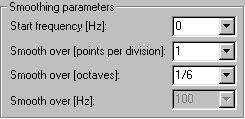
Smoothing parameters
Contains the parameters for the various types of smoothing described above. Parameters that are not used for the chosen smoothing type are disabled.


Determines the frequency where the smoothing starts. Below this frequency, nothing is plotted if the smoothing type is Octave - low frequency correction, Octave - no correction or Constant. If the smoothing type is Constant (low freq.) - Octave (high freq.), then constant bandwidth smoothing is performed below this “start frequency” and octave smoothing is performed above.

Determines how many points are to be computed and plotted within each division. The value may be typed or chosen from the list. If the smoothing type Octave - low frequency correction or Octave - no correction is selected, it gives the number of points within the octave fraction band specified (see Smooth over [octaves]). There are more points at high frequency when plotting on a logarithmic x-axis, but using this method we end up with a constant number of points over the whole frequency range. The software SMAART® uses the term Fixed Points Per Octave (FPPO).
If the smoothing type Constant is selected, it gives the number of points within the constant band specified (see Smooth over [Hz]).
If the number is larger than 1, it is the same as doing a sliding window smoothing because the windows will overlap.

Determines the smoothing bandwidth in octaves. The value may be typed or chosen from the list. This is used if the smoothing type is Octave - magnitude mean/interpolation, Octave - low frequency correction, Octave - no correction and for the octave smoothing part of Constant (low freq.) - Octave (high freq.).

Determines the constant smoothing bandwidth in Hertz. The value may be typed or chosen from the list. This is used if the smoothing type is Constant and for the constant bandwidth smoothing part of Constant (low freq.) - Octave (high freq.).